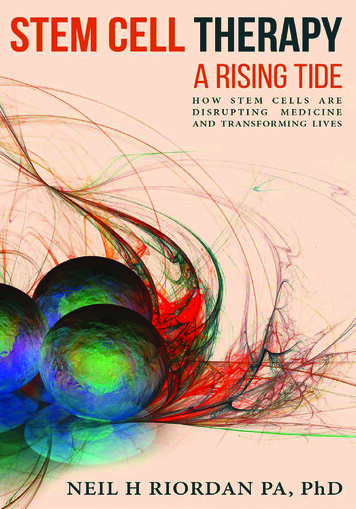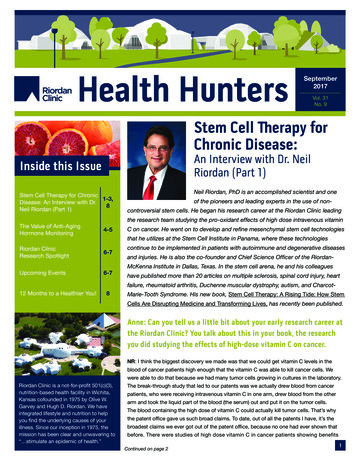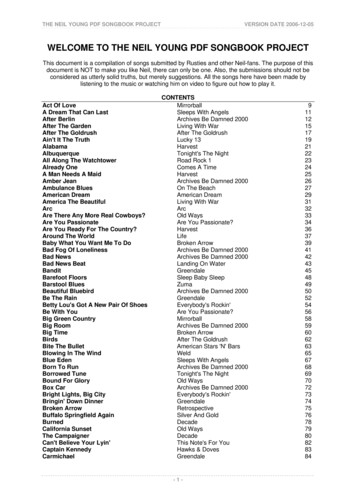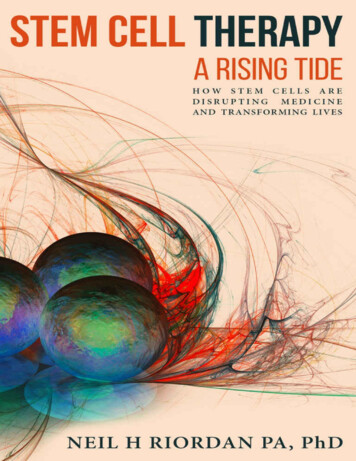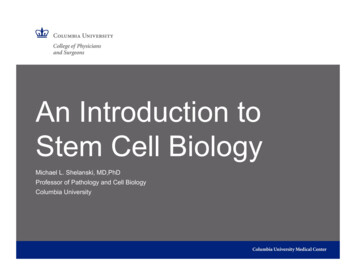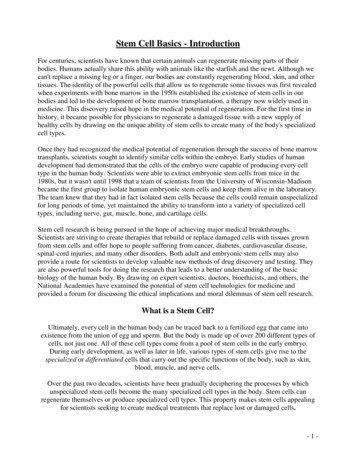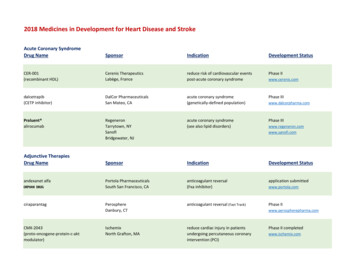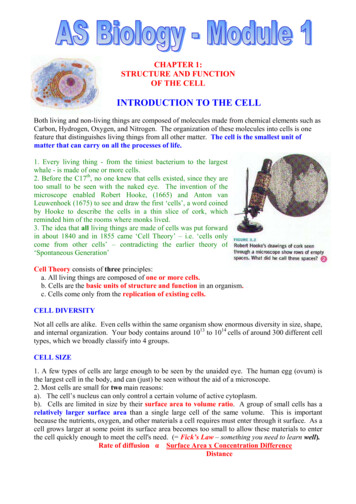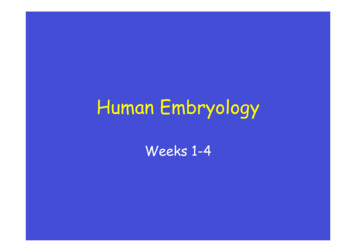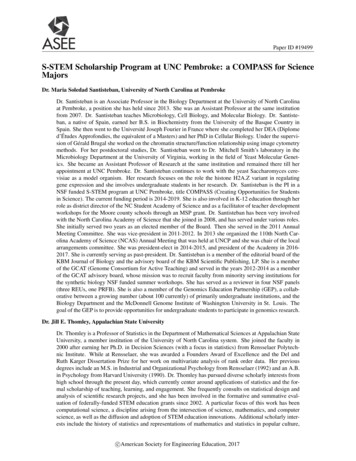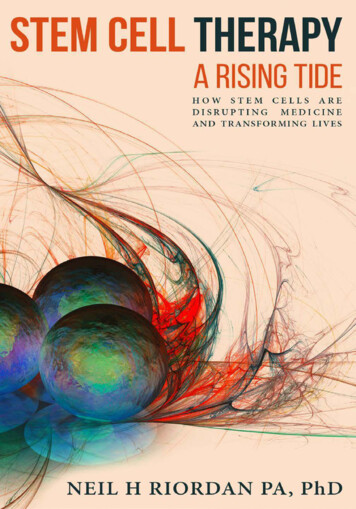
Transcription
Stem Cell TherapyA Rising T ideHow Stem Cells areDisrupting Medicine andTransforming LivesNeil H. Riordan
Stem Cell Therapy: A Rising TideHow Stem Cells are Disrupting Medicine and Transforming LivesCopyright 2017 by Neil Riordan, PA, PhDAll rights .comNo part of this book may be used or reproduced in any manner whatsoever withoutwritten permission from Neil Riordan, except as provided by the United States of Americacopyright law or in the case of brief quotations embodied in articles and reviews.This book is not intended as a substitute for the medical advice of physicians. Theinformation provided in this book is designed solely to provide helpful information on thesubjects discussed. The reader should regularly consult a physician in matters relating totheir health and particularly with respect to any symptoms that may require diagnosis ormedical attention. While all the stories in this book are true, some names and identifyingdetails have been changed to protect the privacy of the people involved.Layout design by www.iPublicidades.comIllustrations byBlake Swanson – Innercyte: Medical Art StudiosSteve Lewis – Blausen MedicalStem Cell Institute & Riordan-McKenna InstituteCovert design by n23artPrinted in the United States of America.First Printing: 2017ISBN: 978-0-9990453-0-5
TABLE OF CONTENTSForeword . vIntroduction . viiCHAPTER ONE: The Seed Is Planted—Hope for MuscularDystrophy . 1CHAPTER TWO: The Body’s Innate Healing Ability—Cancer Spelled Backwards . 11CHAPTER THREE: Redirecting the Immune System—Cancer Exposed . 21CHAPTER FOUR: Getting Started with Stem Cells . 31CHAPTER FIVE: Stem Cells in Action . 45Arnold Caplan Interview .49Robert Harari Interview .67CHAPTER SIX: Spinal Cord Injury—The Ultimate Repair . 77CHAPTER SEVEN: Multiple Sclerosis—Calming the Immune System . 91Bob Harman Interview .98CHAPTER EIGHT: Heart Failure Turnarounds—A New Approach . 113— iii —
Stem Cell Therapy: A Rising TideCHAPTER NINE: Frailty of Aging—Reversing the Inevitable . 125CHAPTER TEN: Respiratory Disorders—A Fresh Breath . 141CHAPTER ELEVEN: Arthritis—A New Solution . 149CHAPTER TWELVE: Biologics in Orthopedics—The Riordan McKenna Institute . 163CHAPTER THIRTEEN: Autism—Progress, Not Regression . 185CHAPTER FOURTEEN: Ulcerative Colitis—Autoimmunity in the Gut . 201CHAPTER FIFTEEN: Diabetes—A Paradigm Shift . 205CHAPTER SIXTEEN: Lupus—An Opportunity inAutoimmune Health . 211CHAPTER SEVENTEEN: Magic Juice—The Elixir of Life? . 215CHAPTER EIGHTEEN: Lifestyle Choices—How to Protect Your Health . 221CHAPTER NINETEEN: Controversy and Legality . 231Conclusion . 243Epilogue . 249References . 255Acknowledgments . 287— iv —
ForewordAs I read this book, I became very emotional. I had to go back about 28 yearsago when my wife and I sat in a doctor’s office and listened to a neurologistlist in grim detail how our beautiful three-year-old son Ryan would spendhis next 20 years. The doctor told us there was nothing that they could do atthat time. He suggested that we do everything we could to keep Ryan activein order to maintain the strength he had as long as possible. And hopefullyin the next 20 years they might find a cure for muscular dystrophy. Theprognosis changed our lives forever. It was a very painful time for all of us.As I continued to read about all of the patients who have been treatedby Dr. Riordan, I realized that we all had one thing in common: traditionalmedicine had given up on us. There was nothing that could be done. Ourown government, founded on the premise of life, liberty, and the pursuit ofhappiness, had evolved into overreaching bureaucracy that would attempt toprevent us from seeking lifesaving alternative treatments.But once again, we all had something else in common. We found a manwho was willing to do everything in his power to offer us options and give ushope for the future of our loved ones. Dr. Riordan has truly dedicated himselfto his profession as a medical pioneer. He has sacrificed everything he hasto give those who have been told there are no options a fighting chance andreal hope for the future.— v —
Stem Cell Therapy: A Rising TideDr. Riordan has never wavered in the face of scrutiny. It takes true courageto stand up to the often judgmental “traditional” medical community—thosewho act offended when you suggest that there might be a different way.Fortunately for all of us, Dr. Riordan had the foresight to look beyondthe walls of traditional medicine and fight the fight for us. I encourage youto read this book, and not just the chapters related to your condition. As awhole, the book lays out Dr. Riordan’s courageous and successful journeythrough his stories and the stories of his patients.Thank you, Dr. Riordan, for all that you have done for us and our families.You truly are a hero!George Benton, Ryan’s father— vi —
IntroductionBY ARNOLD CAPLAN, PHDNeil Riordan, PhD, PA is a pioneer of the highest order, in some ways likeJohn Glenn or Neil Armstrong. Neil has ventured where the routes wereuncharted and the dangers huge. His rocket of cell therapy was launchedon a rickety platform filled with hopes and dreams, and powered by anengine of money. This pioneer has hacked his way through the jungle ofnaysayers and has produced miracles of enormous proportions. He hastaken our scientific dreams and translated them into a high-caliber medicalfacility that does good by offering exposure to cell therapy treatments thatwe working scientists only dream about.Although there are those in my professional realm who would say thatNeil is a medical “cowboy” who “experiments” with human subjects, I wouldsay that he is providing access to therapies that are no more experimentalthan one sees every single day in the surgical suites of major medicalcenters. In such situations, the surgeon is “forced” to improvise because ofthe complexity of the wound field. Such improvisation sometimes involvesusing materials that are not approved but that the surgeon “feels” will workwell in the situation he faces. For example, human decellularized skin fromdead people was approved for topical applications for ulcerated wounds indiabetic patients. But these “membranes” are fabulous for closing abdominalsurgical wounds in hernia repair operations and have changed the way suchclosures are done. This surgical improvision, originally performed by a“cowboy” surgeon, is now the standard of care. We move forward in medicineby the skill and insightful work of pioneers—some with IRB approval andsome not. Riordan’s procedures with MSCs currently have IRB approvals.— vii —
Stem Cell Therapy: A Rising TideIn a sense of transparency, let me say that I have accepted honorariafrom Neil Riordan and gifts of hotel rooms, meals, and, indeed, infusionsof MSCs. These all have monetary value, but none influences my opinion.The monetary success of Neil’s enterprises evoke jealousy in someentrepreneurs, but Neil’s continual reinvestment of money into his nextmedically successful enterprise displays his true motives—the advancementof a medically necessary science despite great obstacles. The key to hissuccess is in the enormously high quality of his facilities; the people, doctors,nurses, receptionist, PR team, etc. are all highly principled and care aboutthe patients they serve. These people care about what they do because Neilrecruits them for their skills and attitude. He does not discuss this in thisbook, but they are present on every page. He talks about Dr. Paz, but he doesnot tell you of his long medical experience and his reputation in the UnitedStates and in Panama for caring and experienced medical judgements. In allof Neil’s clinics, quality control labs, hotels for patients, and restaurants wherethey eat, the staff behind the scenes are dedicated to providing the highestquality medical care possible. Some clinics and hospitals in the United Statescould take lessons from the Riordan gang. That said, the cell-based therapiesNeil’s clinics provide have not all been approved and tested by double-blind,placebo control and rigorously monitored clinical trials, although such trialsare currently underway. But, like innovative surgeons, these open-label useshave proven effective, as hopefully we will see in published peer-reviewedreports of his studies.Each chapter of this book recounts the personal stories of how Neil’sunwavering confidence that cell-based therapies with MSC preparationsfrom fat, marrow, or umbilical cords can make a medical difference. Neilmade medical tourism work, and what he has done is highly laudable, notonly because of the patients he has helped, but because of the laws that havebeen written to support cell-based therapies in Panama. This book is notwhat I pleaded with Neil to write, however. I have, for many years, beggedhim to give us outcome reports of his many patients: what they have asclinical problems, what they walk in with, and the longitudinal outcomesafter the cell infusions. Hopefully these will be forthcoming, but they are notin this book. What is here in these pages is, none-the-less, amazing.— viii —
IntroductionI first learned about Neil’s clinic in Costa Rica and thought his proceduresand therapies were brilliant. And these were crude compared to thosecurrently underway in Panama. The Panama GMP-production facilities,his offices and treatment rooms, and the products including MSCs fromumbilical tissue are of the highest quality. These are the vehicles and theplatform that allow him to write this treatise of the therapies they provide.It is a shame that we have to fly to Panama to have access to these therapiesinstead of having them available in the United States. How long will it takefor such therapies to be available to the patients covered by Medicaid orMedicare instead of those from Beverly Hills or Long Island who can affordto travel to Panama?Almost daily I receive emails from people who want access to “stem cell”treatments. I tell them that I am just a PhD researcher and cannot suggestan avenue of treatment for medical issues. If you have this book in hand,read the chapters. They are honest, open, and spellbinding. While Neil isnot a medical doctor, his clinical experience as a physician assistant alongwith his research background have prepared him for the serious medicalissues for which Neil has organized cell therapy treatments, often with quitesignificant outcomes. Neil is certainly a student of the medical arts and anexpert using innovative treatments. I have talked to patients of Neil’s clinicsand their family members about their treatments; the stories told in this bookare just the tip of the iceberg. This is an interesting book and an interestingand gutsy journey of Neil Riordan. His physician father would be proud torecognize Neil’s passion and medical achievements.Arnold I. Caplan, PhDSkeletal Research CenterDepartment of BiologyCase Western Reserve University10600 Euclid AvenueCleveland, Ohio 44106January 15, 2017— ix —
Chapter TwelveBIOLOGICS INORTHOPEDICS—THE RIORDAN-MCKENNAINSTITUTEI met R. Wade McKenna, DO at a conference in Florida where we wereboth speaking. I was interested in his use of biologics in orthopedic surgerypractice. Biologics are medical products derived from living sources. Stemcells are a type of biologic. Dr. McKenna started out by using the onlybiologic available to orthopedic doctors in the United States at the time:platelet-rich plasma (PRP). PRP is essentially made up of the growth factorsfrom whole blood. In orthopedics, PRP is actually a mixture of white bloodcells and platelet-rich plasma. PRP is used to augment the healing responsein soft tissue injuries such as tendon and muscle tears. Before biologics cameinto use, patients were usually given steroid injections to ease pain from softtissue injuries.Steroids make the injury feel better short term, but in the long run,they actually tear up the tissue, breaking down proteins and sometimesworsening the injury rather than healing it. They do nothing to address theunderlying problem, which is how to regenerate damaged or degeneratedtissue. Eventually, the patient may need surgery due to the damage.— 163 —
Stem Cell Therapy: A Rising TideDo Steroid Injections Help or Harm?Inflammation of the joints can be treated with a combination of a local anesthetic andcorticosteroids to reduce pain. However, this treatment can induce death in cartilagecells,1,2 especially at higher doses,3 raising questions about the benefit when usedfor osteoarthritis. Animal models, particularly in horses, show a detrimental effect ofcorticosteroids on cartilage:4 treatment with corticosteroids alters cartilage and collagenproduction not just in the treated joint(s) but also in untreated joints, an effect that mayspread to the rest of the body.5 Similar negative effects to cartilage tissue have also beenobserved in dog models in vivo, and in vitro.6,7— 164 —
Biologics in Orthopedics—The Riordan McKenna InstituteSteroids are associated with damage to cartilage cells and with avascular necrosis of thejoints, along with other negative effects on the body: Decrease overall immunity Toxic to stem cells Destroy body’s capacity to repair tendonsThe progression of osteoarthritis was shown to continue regardless of corticosteroidtreatment as early as 1993: the knees of steroid-treated patients showed more degeneration(78.6 percent) than the knees of those who did not receive treatment (52.4 percent).8 Morerecently, the use of corticosteroids has been shown to have fewer long-term benefits forlateral epicondylitis, more commonly known as tennis elbow—an inflammation in theelbow region with damage to the tendons and muscles in the joint area. Despite positiveshort-term effects, injections with corticosteroids have been found to be no better in thelong term than injections with a placebo,9,10,11,12 with higher recurrence rates after a year.13Interestingly, steroids are naturally secreted in the body by the adrenal cortices in responseto stress only in the absence of sufficient vitamin C. The adrenal cortices have the highestconcentration of vitamin C of any tissue in the body. When the body is under stress, vitaminC is secreted from the adrenals first, having a potent anti-inflammatory effect in the body.We routinely put our orthopedic patients on oral vitamin C, and we give a vitamin C IV afterevery surgery to replenish the body’s and the adrenals’ supply.It makes sense evolutionarily that if the building blocks of repair are not available to heala wound, the wound will remain in a chronically inflamed state. Vitamin C is crucial forcollagen production and therefore wound healing. If the adrenals are out of vitamin C, thesecreted corticosteroids may have an anti-inflammatory effect, but their catabolic action isinferior to the vitamin C they are replacing.Dr. McKenna was the first orthopedic surgeon in the entire countyof Wise, Texas. As the only orthopedic surgeon, he developed long-termrelationships with his patients, whom he would see at repeat visits for multiplecomplaints. His patients are his neighbors and make up his community. Hejokes that his peer review isn’t at an annual board meeting, it’s every weekat his local Walmart. He couldn’t just send difficult patients off to anotherdoctor—he was their only option. He quickly became proficient at finding— 165 —
Stem Cell Therapy: A Rising TideArthroscopy for Orthopedic InjuriesArthroscopy is a surgical procedure performed with the aid of an arthroscope, a smallcamera-like optical instrument that allows the surgeon to see the interior of an affectedjoint. This procedure usually requires two small incisions, one for the arthroscope and theother for the surgical instrument, making it a minimally invasive intervention under local,regional, or general anesthesia. Arthroscopy may be used in cases of ankle, wrist, shoulder,or elbow damage, but is most commonly used for the knee in meniscal tears or anteriorcruciate ligament (ACL) reconstructions.While recovery time is not as long as it would be with arthrotomy (fully opening thejoint), arthroscopy patients still experience swelling and pain, and necessitate physicalrehabilitation to be able to bear weight in the joint. There is great interest in augmentationin arthroscopic surgery—in particular, the use of biologics to speed recovery time and topromote healing in the affected area. Therapy with platelet-rich plasma (PRP) containinghigh levels of growth factors has shown promising results; studies summarizing multipleclinical trials report pain reduction and a decreased risk of reinjury after PRP treatment forcertain conditions.14,15,16the right treatments for his patients’ ailments. Early on, he used PRP to treat asoftball player with an infrapatellar tendonitis, also known as jumper’s knee.He knew that surgery would likely make her condition worse, ruining hercollege career. He had read a paper on the use of PRP for her condition—fiveout of ten patients healed without needing surgery. He didn’t know anyoneusing the treatment at the time, but he knew her options were limited. Itturned out to be a good choice. She did much better with PRP than shewould have with arthroscopy, the most common surgical procedure for hercondition.Without the growth factors from PRP, a tendon has little chance to healdue to the low blood supply—much like cartilage in people with arthritis.Platelets are designed to heal a wound and stop bleeding as well as recruitcells from the bloodstream and bone marrow to induce healing. When PRPis injected, it sends the message, “this tissue is injured” to the body so thatthe body responds accordingly. With a minimally invasive procedure that— 166 —
Biologics in Orthopedics—The Riordan McKenna Institutetakes fewer than 30 minutes, the softball player was back on the field in sixweeks, playing with no pain.23Later in his practice, Dr. McKenna became aware he could apply theknowledge he had gained using the process of pulling growth factors outof blood to pulling growth factors out of bone marrow, as well as stem cellconcentrate. Whole blood contains very few stem cells, but bone marrow isa rich source of these cells. It is particularly rich in stem cells that promoteangiogenesis, or the development of new blood vessels, which helps tobring needed nutrients to the site of injury. When working with tissues thatnaturally have less blood supply, growth of new blood vessels to the area canmake a big difference.Dr. McKenna had performed many microfracture surgeries, thestandard of care for patients with damaged knee cartilage. The procedureinvolves drilling holes into the knee that go just deep enough to let bonemarrow leak out. In microfracture, the bone marrow is key to promptinghealing of the cartilage. Stem cells and other growth factors from bonemarrow home to the area of damage and promote healing of the cartilage.Whether or not the procedure is successful is largely dependent on howrobust the stem cells are. The problem is, many patients who undergothis procedure do not recover from the injury, or they only recover for acouple years because they were not able to heal the cartilage well enough.Unfortunately, this procedure has poorer outcomes than other cartilagerepair techniques,18 and a paper that reviews 20 years of data in 28 studieshas found that there is insufficient data available on its long-term effects.19As it turns out, the protective covering that grows back to heal the cartilageafter a microfracture procedure is not hyaline, the type of cartilage we areborn with, but fibrocartilage, which is inherently less stable than hyalinewithin joints. Fibrocartilage breaks down more easily than hyaline, whichis why so many microfracture procedures fail.Dr. McKenna was disheartened at the poor success rate of microfracture.He wondered if adding a concentrated bone marrow aspirate might help healthe knee better than the few drops that are extracted during microfracture.— 167 —
Stem Cell Therapy: A Rising TidePlatelet-Rich Plasma (PRP)Treatment with platelet rich plasma (PRP) is a technique to enhance the healing processafter injury. Blood is drawn, generally from the patient’s arm vein, and is then centrifugedto obtain platelets and cytokines in higher concentrations than in circulating blood. Thisprocess separates the PRP product into three distinct layers: 1) red blood cells at thebottom; 2) white blood cells and inflammatory cytokines (the buffy coat) in the middle;and 3) plasma (the liquid part of the blood), containing platelets and growth factors atthe top.There are actually two products that are commonly referred to as PRP. One of them is purePRP. This classical, or true, PRP is made by centrifuging the tube gently so that the plateletsremain suspended in the plasma. The plasma is then transferred to another tube, which iscentrifuged harder so that the platelets separate to the bottom.In the field of orthopedics, PRP is not only PRP—it also includes the white blood cells(from the buffy coat). Most machines that automate this process will also include the whiteblood cells (commonly known as the PBMCs, or peripheral blood mononuclear cells). So, inthe literature there are many articles that refer to PRP when in fact they are describing PRPwith PBMCs. Preferably, you would want the white blood cells in the PRP mixture if the goalis to heal the wound, because it includes cellular components that aid in healing.— 168 —
Biologics in Orthopedics—The Riordan McKenna InstituteOnce the platelets are activated inside the body, they release more growth factors, whichpromotes blood vessel formation. This newly formed blood vessel network allows nutrientsand other cells to be delivered to the area, resulting in a faster recovery with less pain andreduced scarring of the injured tissue. Treatment with PRP is especially useful in orthopedicsand in sports medicine, with notable successes in arthroscopy (anterior cruciate ligamentand meniscal repairs), muscle tears, Achilles tendon injury, and tennis elbow, among manyother injuries.17Dr. McKenna often refers to PRP plus PBMCs as “bone marrow lite.” The bone marrow isa very rich environment of stem cells, including CD34 cells, which are the precursorsto all blood cells, and endothelial progenitor cells (EPCs), which are very important forinducing new blood vessel growth. EPCs and CD34 cells both contribute to new bloodvessel formation. The bone marrow also contains MSCs, which also can enhance newblood vessel growth as well as secrete many trophic factors that stimulate regenerationand decrease inflammation.The problem was, at the time, the procedure involved extracting bonemarrow with a tool called a Jamshidi , a long nail-like needle that is driveninto the hip bone using a mallet. The Jamshidi procedure is painful, requiresthe patient to be put under anesthesia, and involves multiple bone marrowdraws to get a good sample. To bypass this painful and invasive procedure,over the course of six years Dr. McKenna developed an innovative devicethat uses power, creating a round hole in the bone that reduces the impactto the patient and does not require general anesthesia. Over time he has beenable to optimize the amount of extracted mononuclear cells, which includesstem cells, as well as reduce the complications of bone marrow harvests thatcan be painful for the patient.Given the current regulatory environment in the United States, oneof the very few stem cell options available to us is bone marrow aspirateconcentrate (BMAC). Even though it is available in the United States, it israrely paid for by insurance. I believe that soon, that is all going to change.— 169 —
Stem Cell Therapy: A Rising TideStem cells from bone marrow aspirate have been compared to almostevery graft with more success found in the treatment groups receiving bonemarrow. What many orthopedic surgeons did not understand in the pastwas that bone marrow aspirate is not only useful for healing bone, but alsofor other tissues. Dr. McKenna and I published a paper about our treatmentwith bone marrow aspirate concentrate of a 56-year-old woman with Achillestendonopathy and a partially torn Achilles tendon that limited her ability toparticipate in daily activities that involved walking or wearing shoes otherthan sandals.47 To our knowledge, she was the first Achilles tendonopathypatient treated with bone marrow aspirate. Previously an active tennisplayer, she hadn’t been on the court in ten years due to her injury. She hadseen multiple physicians over the years and followed standard conservativetreatment involving stretching and anti-inflammatory medications. She hadopted out of steroid injections and the standard surgery for the injury, butwhen presented with the possibility of an ultrasound-guided bone marrowaspirate concentrate injection of her own bone marrow, a non-invasiveprocedure that takes fewer than 60 minutes, she was interested.Just six weeks after the procedure, the patient reported significantlyless pain upon rest and while walking. The knot in her Achilles tendondecreased to 50 percent of its original size and was no longer tender to thetouch. She was finally able to put on heels and walk over uneven surfaceswithout pain. And best of all, she returned to the court to play tennis for thefirst time in years. An MRI done ten weeks after the procedure showed thather heel looked almost indistinguishable from her other heel, which was notinjured. A regeneration of tissue health such as this is not seen with othertreatment types. Recovery time for the standard surgical procedure for herinjury would have taken at least six months, but would not have restored hertendon as the bone marrow aspirate did, as evidenced by the MRI. Recoverylike this simply doesn’t happen with surgery.Our rationale for treating this woman’s Achilles tendonopathy camefrom our success with using bone marrow concentrate with Achilles tendongrafts in ACL (anterior cruciate ligament) tear repairs of the knee. ACLinjuries are one of the most common injuries and often involve removingpart of the patient’s own tendon from below the kneecap to replace the ACL.This repair takes 369 days to heal, at which point it looks normal on an MRI.— 170 —
Biologics in Orthopedics—The Riordan McKenna InstituteThe patient’s heel on MRI beforetreatment, 10 weeks after treatment,and 32 weeks after treatment. Thereis near complete healing of theaffected tendon. The affected areadecreased from 2.272 cm2 to 1.204cm2.— 171 —
Stem Cell Therapy: A Rising TideHyaline vs. FibrocartilageCartilage is a connective tissue formed by cells called chondrocytes that are stacked withina collagen-based matrix. There are no blood vessels in this structure; nutrients are absorbedvia the matrix, resulting in a limited capacity for regeneration. Cartilage may be classifiedinto three types: hyaline cartilage, fibrocartilage, and elastic cartilage.20Elastic cartilage is found in the ear and throat and is the most pliable of the three types.Fibrocartilage is designed to bear tension and compression, and as such it is a strong type ofcartilage present in the vertebral discs of the spine, in the meniscus, at the end of tendons,and in the callus structure of the bones. Hyaline cartilage may be found in the rib areaand in the more mobile articular joints (wrists, elbows, shoulders, hips, knees, etc.) wheresynovial fluid reduces friction in the space between the bones.Unfortunately, the tendon that is removed from below the kneecap oftendoes not heal properly, sometimes resulting in tendonitis or a shorteningof the tendon, both of which affect the placement of the kneecap and canlead to arthritis. Dr. McKenna prefers to use a sterilized graft of an Achillesheel taken from a cadaver, which can be better tailored to the size of thenew ACL without needing to remove the patient’s own tendon. He injectsbone marrow concentrate at the site of the injury, and healing time is fewerthan 24 weeks, which is about half the time of the conventional treatment.He is able to avoid the complications of conventional treatment and get hispatients back to their normal lives sooner.23Teresa Hamrick is a registered nurse from Tallahassee, FL. In 1983 shewas injured in a bike accident but brushed off the injury and continuedto walk around as nor
THE RIORDAN-MCKENNA INSTITUTE I met R. Wade McKenna, DO at a conference in Florida where we were both speaking. I was interested in his use of biologics in orthopedic surgery practice. Biologics are medical products derived from living sources. Stem cells are a type of biologic. Dr. McKenna started out by using the only
